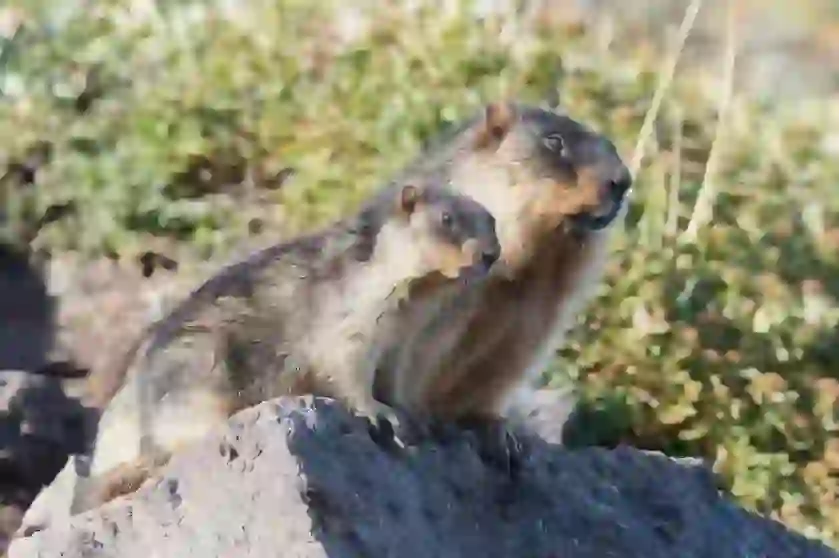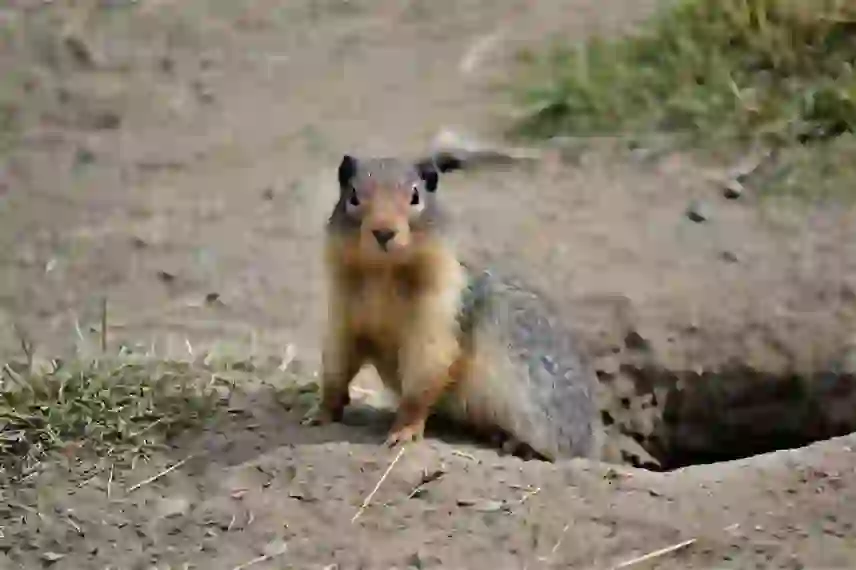
Marmot
Marmot
Marmot
Marmots are charming animals that stand on their hind legs. In the Alps region, such as Switzerland, marmot stuffed animals and other souvenirs are very popular. But marmots can also make amazing screams that you wouldn’t expect from their cute appearance. Marmots have many other attractions and surprising behaviors. Let’s find out more about marmots.
Marmot Basic Infomation

Marmots, with their charming appearance standing on two legs, are popular in the Alpine regions such as Switzerland, where marmot plush toys are common souvenirs. However, contrary to their cute appearance, marmots can also emit incredibly loud cries.
There's so much more to discover about the charming and surprising behaviors of marmots! Let's learn more about marmots.

Classification
Order Rodentia, Family Sciuridae, Subfamily Xerinae, Tribe Marmotini, Genus Marmota

Body Length
Body length ranges from about 30 cm in smaller species to around 75 cm in the largest species. Tails measure 10 to 25 cm, and the weight ranges from about 2 to 7.5 kg.
While the smallest species is not clearly defined, the largest species is the Olympic marmot (subgenus Petromarmota).

Features of Marmots
Marmots of the genus Marmota are large ground squirrels with short tails, rounded bodies, and large incisors. They rarely climb trees and typically dig tunnels and create burrows in mountainous or grassland terrains where they reside. Marmots have short, strong forelimbs and large curved claws, making them proficient diggers.
Marmots are active from mid-April to late September but hibernate from early October to mid-April. As hibernation approaches, marmots eat extensively to store nutrients and accumulate fat. During this period, marmots gain significant weight.
After waking from hibernation, it's mating season for marmots. They mate in April and May, and females give birth to 2 to 5 young.
The gestation period is about 30 to 32 days. Marmot young often start venturing outside the burrow at around six weeks old and reach sexual maturity in two years.

Habitats of Marmots
Marmots inhabit various locations depending on the species, but many are found in the mountainous or highland regions of the Eurasian continent. The Siberian marmot lives across areas from China to Mongolia, and the Alpine marmot inhabits the high mountain regions of Europe. In tourist spots in Switzerland, Austria, and southern Germany, marmot plush toys and other souvenirs are popular among tourists.
In North America, the woodchuck (also known as the groundhog) resides in plains and near forests.
Marmot Q&A

What is the origin of the name 'marmot'?
The word 'marmot' originates from the French word 'marmotte', which derives from the Romansh word 'murmont' used in southeastern Switzerland, further originating from the Latin 'murem montis' (accusative case of 'mus montis', meaning 'mountain mouse').
Additionally, there is another theory suggesting that the name 'marmot' is derived from the French verb 'marmotter', which means 'to mumble or mutter'.

What are marmot burrows like?
Marmots vary in species, but here we will introduce the burrows of marmots living in the European Alps. Marmots use their long, sturdy claws to skillfully dig tunnels and construct burrows that serve as hiding spots from predators, living quarters (bedrooms), and hibernation chambers. Interestingly, marmot tunnels and burrows even have designated toilet areas at dead ends.
Once completed, a burrow is used by a single family, and may be used by subsequent generations. Some burrows are expanded and become larger and more complex as they are used across generations.

I saw a picture of a marmot standing on two legs; what is it doing?
Hiking in the Alps in places like Switzerland, you might see marmots standing on two legs. This endearing posture is very popular among tourists; however, in reality, these marmots are vigilantly keeping watch. A sentinel marmot will emit a loud whistle-like alarm call to warn its fellows of predators or other dangers.
Interestingly, these alarm calls have different meanings: a long alarm indicates aerial threats like eagles, while a short alarm signals terrestrial threats such as foxes. Upon hearing these, the colony's marmots will quickly run to their burrows, taking shelter while remaining alert to the threat.

What do marmots eat?
Marmots primarily feed on grass, but they also consume fruits, mosses, tree roots, flowers, leaves, and occasionally insects. They eat by holding food with their front paws, a sight that often brings a smile due to its cuteness.
Marmots typically feed in the early morning and late afternoon. They do not adapt well to heat, so they may not eat during very hot days. As summer ends, they eat more to build up layers of fat to survive the long hibernation period. Just before hibernation, their body weight can almost double.

Do marmots play, fight, or socialize?
Marmots are highly social animals that communicate danger to each other with whistle-like sounds and engage in playful wrestling, known as 'play fighting', using their hind legs to push against each other.

Where do marmots hibernate?
Marmots hibernate within their burrows. As the end of summer approaches, they begin preparing their hibernation nests by gathering dry grass and old stems. When it's time to hibernate, they seal the entrance of the burrow with a mixture of soil and their own feces.
During hibernation, marmots huddle together, curled up to begin their sleep. They reduce their digestive system size and regulate metabolic functions. In the case of the Alpine marmot, they can reduce their heart rate to about five beats per minute and breathing to one to three breaths per minute, allowing them to slowly consume the stored fat. Their body temperature drops to nearly match the surrounding temperature, but it increases when the external temperature approaches freezing.

What is marmot parenting like? How long until they mature?
When pregnant, marmots bring materials like grass into their burrows to prepare for birth. The gestation period lasts 33-34 days, resulting in one to seven babies. Fur starts to grow a few days after birth, and the babies are nursed on mother's milk but wean off after about 40 days.
During the weaning period, the mother leaves the babies in the burrow while she forages for food. After weaning, the young start venturing out of the burrow to find their own food. Their fur changes to match the adults' color by the end of summer, and they grow to adult size within two years.

How long do marmots live?
The lifespan of marmots varies; in the wild, they live between two and several decades, while in captivity, such as in zoos, they can live between 15 to 18 years.

Are guinea pigs and marmots related given their similar names?
No, marmots belong to the squirrel family of the Rodent order, while guinea pigs belong to the cavy family of the same order. The name 'guinea pig' was mistakenly introduced to Japan from the Netherlands, where the animal is originally called 'cania'. A trader brought them to Japan and mistakenly referred to them as 'marmot' (marmot), and the name became distorted to 'guinea pig' over time.

Can marmots be kept as pets?
While some vendors sell marmots as exotic pets, they are not suitable for home environments.
This is because marmots are wild animals that live in high mountains or expansive grasslands where they form colonies.
Additionally, they do not thrive in Japan's hot climate. Without access to wide highlands or grasslands to dig burrows, keeping a marmot as a pet may not lead to a happy life for the animal. Outside of environments similar to their natural habitats, such as zoos, it is not advisable to keep marmots as pets.

Is it true that marmots are also used for meat?
Yes, marmots have long been used for meat in regions where they are indigenous. In Switzerland, marmots are hunted during the September and October hunting season, where thousands are captured for population management, and some restaurants offer dishes made from marmot meat.
Recently, the overpopulation of marmots has become a problem in places like Zermatt, causing damage by burrowing into farmlands. As both a tourist attraction and a pest, Switzerland struggles to manage marmots appropriately.
Additionally, as members of the Rodent order, marmots can carry diseases such as plague. In 2020, a Mongolian boy died from bubonic plague after eating marmot meat, highlighting the need for caution.

Where can you meet marmots?
Unfortunately, there are no wild marmots in Japan.
However, you can meet marmots at certain zoos!
In Japan, marmots can be seen at the 'Izu Shaboten Zoo (https://izushaboten.com/bloganimal/7094)'. The zoo houses three Bobak marmots named 'Columbia', 'Montbell', and 'Patagonia'.
For a chance to see wild marmots, Switzerland is the best option. While marmots can be seen during hikes around Zermatt, for a closer view, visit 'Spielboden' on the way up to the Langflue observation deck from Saas-Fee in the Valais region, where you can feed the marmots accustomed to humans. The restaurant at Spielboden also sells marmot feed.

Would you like to become a part of the 'Animalbook.jp'?
Turn your knowledge into Q&A and share it with the world. ※Publication will be activated after purchase. Let's share information together!
Marmot Type of List

Subgenus Marmota
[Marmots Living in Eurasia]
☆Marmots inhabiting mountainous regions and plateaus of Eurasia
・Black-capped Marmot (Black-capped Marmot)
Eastern Siberia. Lives in the Arctic tundra and high mountains near sea level up to 2,000 meters in Russia's Barguzin Nature Reserve.
・Siberian Marmot
Inhabits the Altai Mountains in China, Siberia, and Mongolia.
・Grey Marmot
Inhabits areas such as Siberia.
・Himalayan Marmot
Inhabits the Himalayan Mountains.
・Long-tailed Marmot (Long-tailed Marmot)
Lives in Central Asia's Pamir Plateau at elevations from 3,200m to 5,000m, in grasslands and rocky areas.
・Menzbier's Marmot (Tien Shan Marmot)
Inhabits Central Asia, including the Tien Shan Mountains.
・Alpine Marmot
Inhabits the European Alps, Pyrenees, northern Apennines, Carpathians, and Tatra Mountains.
☆Marmots living in forests and steppes of Eurasia
・Forest-steppe Marmot
Lives in the forests and steppes of southern Russia.
・Bobak Marmot (also known as Steppe Marmot, Tarbagan)
Inhabits the steppes of Eastern Europe and Central Asia.
[Marmots Living in the Americas]
☆Marmots inhabiting mountainous regions of the American continents
・Alaska Marmot
Lives in the Brooks Range, Alaska.
☆Marmots inhabiting plains of the American continents
・Woodchuck (also known as Groundhog)
Inhabits the plains and forest edges in Canada and the northeastern and central United States, from Alaska to Georgia.
Subgenus Petromarmota
・Hoary Marmot
Primarily inhabits mountainous areas at elevations around 2,500 meters in Alaska and northwestern Canada.
・Olympic Marmot
Lives exclusively on the Olympic Peninsula in Washington State, USA. This isolated peninsula is surrounded by high mountains.
・Vancouver Marmot
Exists only on Vancouver Island in British Columbia, Canada. Listed as an endangered species.
・Yellow-bellied Marmot
Inhabits grasslands and origins in the western United States and southwestern Canada, including the Rocky and Sierra Nevada mountains.
Extinct Marmots
・Marmot Lobusta (China)
・Marmot Arizonae (USA, Arizona)
・Marmot Minera (USA, Nevada)
・Marmot Betas (USA, Nebraska)
Information
Congratulations! You are the first commenter!

Create Your Favorite List!
Marmot
Save the animals you love! Build your own list to quickly revisit your favorites later.

Would you like to leave a comment?
※Please note: This is for the purchase of rights to post comments within the article.
Find Your Favorites!
Our shop offers a unique and attractive selection of goods themed around various animals.
Marmot References
Marmot Introduction of media used
出典:https://pixabay.com/videos/id-41703/
出典:https://www.pexels.com/ja-jp/photo/857102/

出典:https://pixabay.com/images/id-2638640/

出典:https://unsplash.com/photos/LVNTy9p_s9M

出典:https://pixabay.com/images/id-3463227/

出典:https://pixabay.com/images/id-3374978/

出典:https://commons.wikimedia.org/wiki/File:Marmota_baibacina.jpg

出典:https://pixabay.com/images/id-4693792/

出典:https://pixabay.com/images/id-1574869/

出典:https://pixabay.com/images/id-269407/

出典:https://pixabay.com/images/id-385537/

出典:https://pixabay.com/images/id-1755119/

出典:https://commons.wikimedia.org/wiki/File:Marmota_marmota_06.jpg

出典:https://commons.wikimedia.org/wiki/File:Marmota_monax_UL_07.jpg

出典:https://unsplash.com/photos/pi_On0FTJFk/

出典:https://pixabay.com/images/id-2638617/

出典:https://pixabay.com/images/id-4280673/

出典:https://pixabay.com/images/id-2638632/

出典:https://pixabay.com/images/id-5508697/

出典:https://pixabay.com/images/id-5946109/

Help Enrich Our Animalbook.jp with Your Media!
We are constantly looking to expand and enrich our Animalbook.jp with amazing photos and videos of animals. If you have any media that you'd like to share, please contribute and help us showcase the beauty and diversity of the animal kingdom. Your submissions will be credited and featured in our encyclopedia, reaching a wide audience of animal lovers.





















